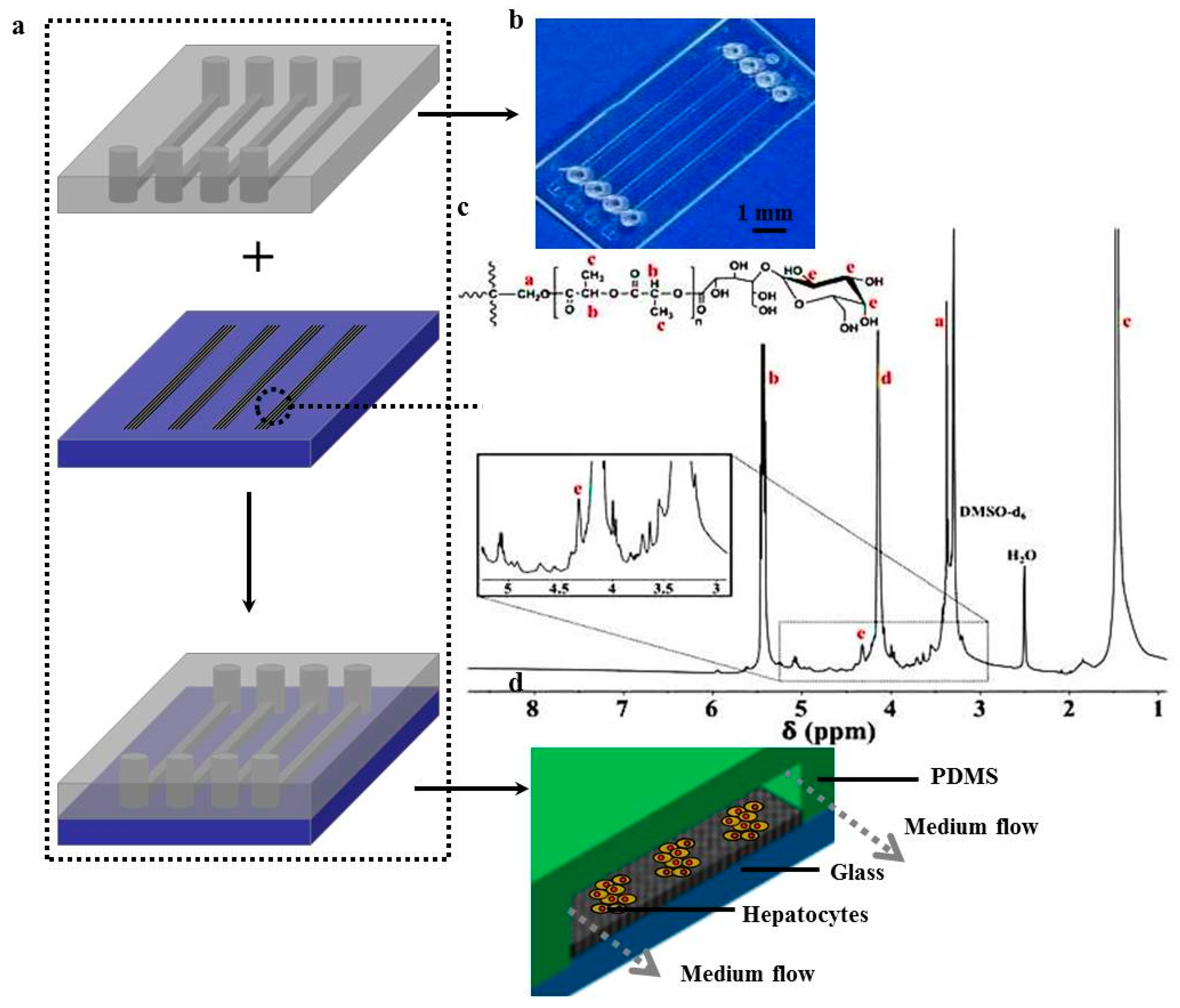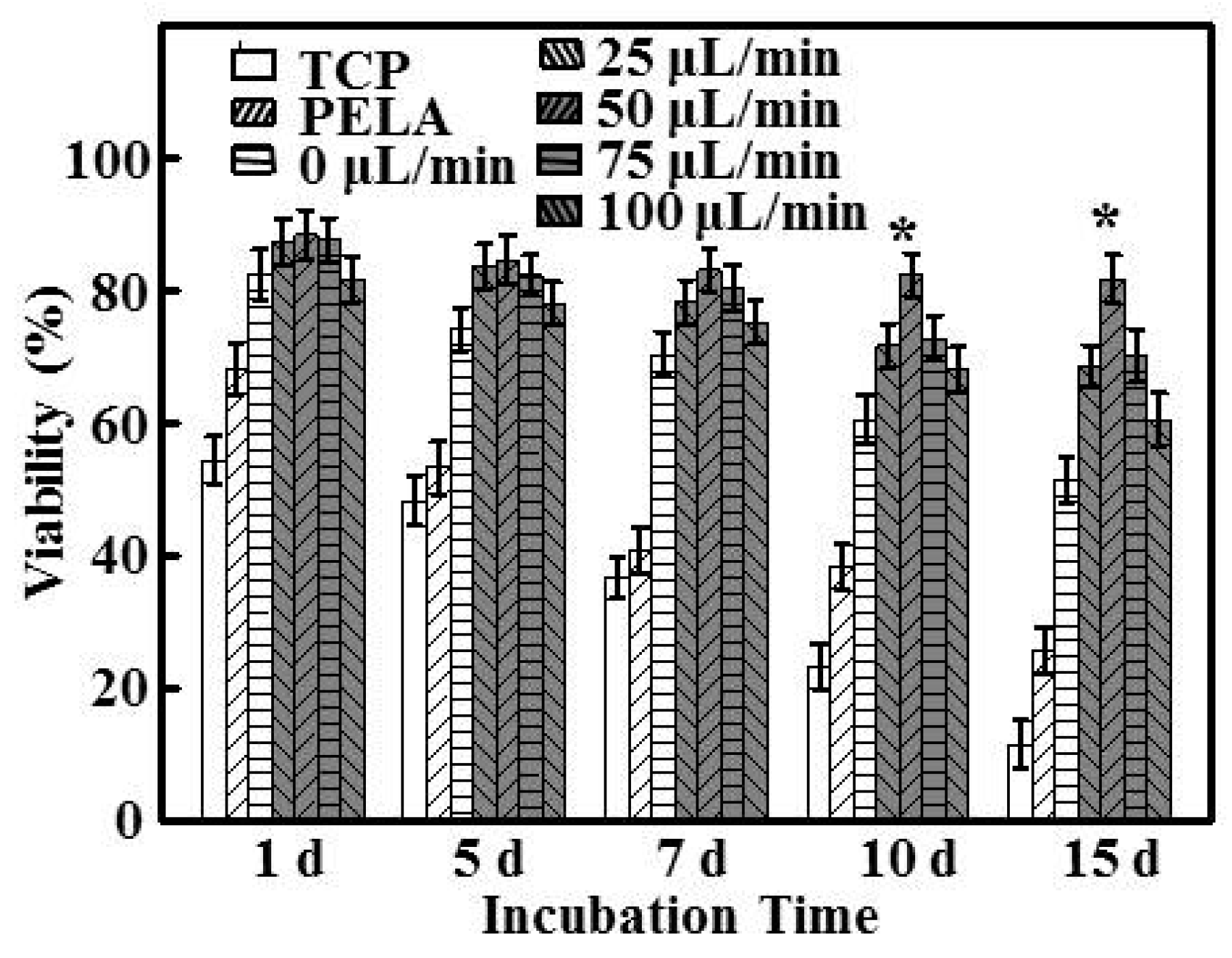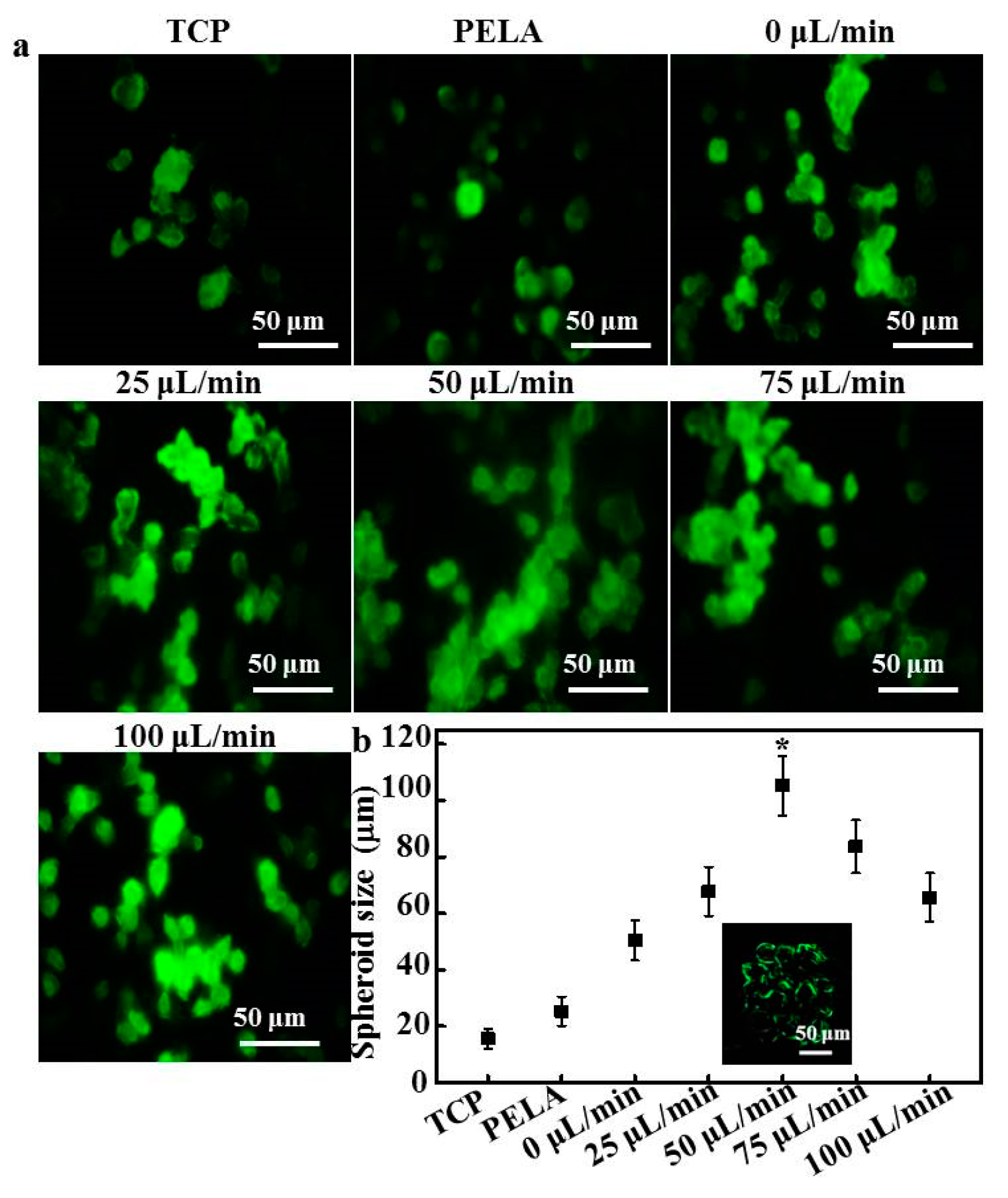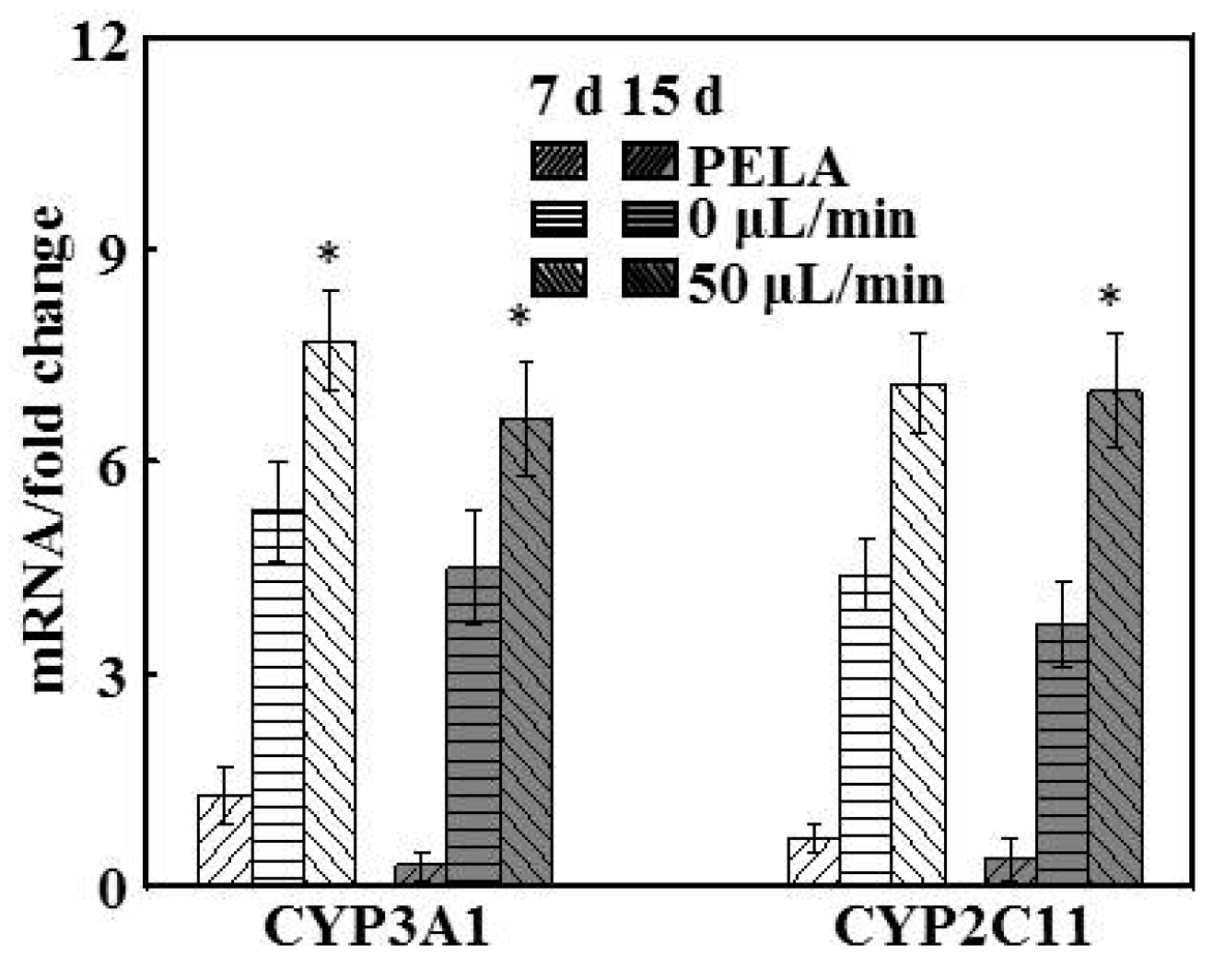Primary Hepatocytes Cultured on a Fiber-Embedded PDMS Chip to Study Drug Metabolism
Abstract
:1. Introduction
2. Materials and Methods
2.1. Materials
2.2. Fabrication of the Fiber-Based Microfluidic Chip
2.3. Cell Culture
2.4. Characterization of Cultured Hepatocytes
2.5. Characterization of Enzyme Activities of Cultured Hepatocytes
2.6. Gene Expression of Enzymes from Cultured Hepatocytes
2.7. Drug Metabolism Testing in Cultured Hepatocytes
2.8. Statistical Analysis
3. Results and Discussion
3.1. Microfluidic Device Assembly
3.2. Optimization of the Flow-Based Chip
3.3. Fluorescence Staining, Size Distribution, and Upscaling the Device
3.4. Hepatocyte Functions
3.5. Gene Expression of Metabolic Enzymes
3.6. Hepatocyte Drug-Metabolizing Enzymes
3.7. Drug Metabolism Tests on Cultured Hepatocytes
4. Conclusions
Acknowledgments
Author Contributions
Conflicts of Interest
References
- Greenhough, S.; Medine, C.N.; Hay, D.C. Pluripotent stem cell derived hepatocyte like cells and their potential in toxicity screening. Toxicology 2010, 278, 250–255. [Google Scholar] [CrossRef] [PubMed]
- Asthana, A.; Kisaalita, W.S. Biophysical microenvironment and 3D culture physiological relevance. Drug Discov. Today 2013, 18, 533–540. [Google Scholar] [CrossRef] [PubMed]
- Langsch, A.; Bader, A. Longterm stability of phase I and phase II enzymes of porcine liver cells in flat membrane bioreactors. Biotechnol. Bioeng. 2001, 76, 115–125. [Google Scholar] [CrossRef] [PubMed]
- Tung, Y.C.; Hsiao, A.Y.; Allen, S.G.; Torisawa, Y.S.; Ho, M.; Takayama, S. High-throughput 3D spheroid culture and drug testing using a 384 hanging drop array. Analyst 2011, 136, 473–478. [Google Scholar] [CrossRef] [PubMed]
- Lin, R.Z.; Chang, H.Y. Recent advances in three-dimensional multicellular spheroid culture for biomedical research. Biotechnol. J. 2008, 3, 1172–1184. [Google Scholar] [CrossRef] [PubMed]
- Chen, Y.A.; King, A.D.; Shih, H.C.; Peng, C.C.; Wu, C.Y.; Liao, W.H.; Tung, Y.C. Generation of oxygen gradients in microfluidic devices for cell culture using spatially confined chemical reactions. Lab Chip 2011, 11, 3626–3633. [Google Scholar] [CrossRef] [PubMed]
- Anada, T.; Fukuda, J.; Sai, Y.; Suzuki, O. An oxygen-permeable spheroid culture system for the prevention of central hypoxia and necrosis of spheroids. Biomaterials 2012, 33, 8430–8441. [Google Scholar] [CrossRef] [PubMed]
- Gebhardt, R.; Mecke, D. Perifused monolayer cultures of rat hepatocytes as an improved in vitro system for studies on ureogenesis. Exp. Cell Res. 1979, 124, 349–359. [Google Scholar] [CrossRef]
- Xia, L.; Ng, S.; Han, R.; Tuo, X.; Xiao, G.; Leo, H.L.; Cheng, T.; Yu, H. Laminar-flow immediate-overlay hepatocyte sandwich perfusion system for drug hepatotoxicity testing. Biomaterials 2009, 30, 5927–5936. [Google Scholar] [CrossRef] [PubMed]
- Domansky, K.; Inman, W.; Serdy, J.; Dash, A.; Lim, M.H.; Griffith, L.G. Perfused multiwell plate for 3D liver tissue engineering. Lab Chip 2010, 10, 51–58. [Google Scholar] [CrossRef] [PubMed]
- Viravaidya, K.; Shuler, M.L. Incorporation of 3T3-L1 cells to mimic bioaccumulation in a microscale cell culture analog device for toxicity studies. Biotechnol. Prog. 2004, 20, 590–597. [Google Scholar] [CrossRef] [PubMed]
- Sung, J.H.; Shuler, M.L. A micro cell culture analog (µCCA) with 3-D hydrogel culture of multiple cell lines to assess metabolism-dependent cytotoxicity of anti-cancer drugs. Lab Chip 2009, 9, 1385–1394. [Google Scholar] [CrossRef] [PubMed]
- Gebhardt, R.; Hengstler, J.G.; Müller, D.; Glöckner, R.; Buenning, P.; Laube, B.; Schmelzer, E.; Ullrich, M.; Utesch, D.; Hewitt, N.; et al. New hepatocyte in vitro systems for drug metabolism: Metabolic capacity and recommendations for application in basic research and drug development, standard operation procedures. Drug Metab. Rev. 2003, 35, 145–213. [Google Scholar] [CrossRef] [PubMed]
- Torisawa, Y.S.; Chueh, B.H; Huh, D.; Ramamurthy, P.; Roth, T.M.; Barald, K.F.; Takayama, S. Efficient formation of uniform-sized embryoid bodies using a compartmentalized microchannel device. Lab Chip 2007, 7, 770–776. [Google Scholar] [CrossRef] [PubMed]
- Lan, S.F.; Starly, B. Alginate based 3D hydrogels as an in vitro co-culture model platform for the toxicity screening of new chemical entities. Toxicol. Appl. Pharmacol. 2011, 256, 62–72. [Google Scholar] [CrossRef] [PubMed]
- Nugraha, B.; Hong, X.; Mo, X.; Tan, L.; Zhang, W.; Chan, P.M.; Kang, C.H.; Wang, Y.; Beng, L.T.; Sun, W.; et al. Galactosylated cellulosic sponge for multi-well drug safety testing. Biomaterials 2011, 32, 6982–6994. [Google Scholar] [CrossRef] [PubMed]
- Liu, Y.; Zhang, L.; Wei, J.; Yan, S.; Yu, J.; Li, X. Promoting hepatocyte spheroid formation and functions by coculture with fibroblasts on micropatterned electrospun fibrous scaffolds. J. Mater. Chem. B 2014, 2, 3029–3040. [Google Scholar] [CrossRef]
- Liu, Y.; Li, H.; Yan, S.; Wei, J.; Li, X. Hepatocyte cocultures with endothelial cells and fibroblasts on micropatterned fibrous mats to promote liver-specific functions and capillary formation capabilities. Biomacromolecules 2014, 15, 1044–1054. [Google Scholar] [CrossRef] [PubMed]
- Liu, Y.; Zhang, L.; Li, H.; Yan, S.; Yu, J.; Weng, J.; Li, X. Electrospun fibrous mats on lithographically micropatterned collectors to control cellular behaviors. Langmuir 2012, 28, 17134–17142. [Google Scholar] [CrossRef] [PubMed]
- Liu, Y.; Wang, S.; Wang, Y. Patterned fibers embedded microfluidic chips based on PLA and PDMS for Ag nanoparticle safety testing. Polymers 2016, 8, 402. [Google Scholar] [CrossRef]
- Liu, Y.; Yang, D.; Yu, T.; Jiang, X. Incorporation of electrospun nanofibrous PVDF membranes into a microfluidic chip assembled by PDMS and scotch tape for immunoassays. Electrophoresis 2009, 30, 3269–3275. [Google Scholar] [CrossRef] [PubMed]
- Yan, J.; He, X.; Feng, S.; Zhai, Y.; Ma, Y.; Liang, S.; Jin, C. Up-regulation on cytochromes P450 in rat mediated by total alkaloid extract from Corydalis yanhusuo. BMC Complement Altern. Med. 2014, 14, 306–314. [Google Scholar] [CrossRef] [PubMed]
- Huang, Y.; Zheng, S.L.; Zhu, H.Y.; Xu, Z.S.; Xu, R.A. Effects of aescin on cytochrome P450 enzymes in rats. J. Ethnopharmacol. 2014, 151, 583–590. [Google Scholar] [CrossRef] [PubMed]
- Goodwin, A.C.; Shields, C.E.D.; Wu, S.; Huso, D.L.; Wu, X.; Murray-Stewart, T.R.; Hacker-Prietz, A.; Rabizadeh, S.; Woster, P.M.; Sears, C.L.; et al. Polyamine catabolism contributes to enterotoxigenic Bacteroides fragilis-induced colon tumorigenesis. Proc. Natl. Acad. Sci. USA 2011, 108, 15354–15359. [Google Scholar] [CrossRef] [PubMed]
- Tucker, G.T.; Houston, J.B.; Huang, S.M. Optimizing drug development: Strategies to assess drug metabolism/transporter interaction potential—Towards a consensus. Br. J. Clin. Pharmacol. 2001, 52, 107–117. [Google Scholar] [CrossRef] [PubMed]
- Houston, J.B. Utility of in vitro drug metabolism data in predicting in vivo metabolic clearance. Biochem. Pharmacol. 1994, 47, 1469–1479. [Google Scholar] [CrossRef]
- Chao, P.; Maguire, T.; Novik, E.; Cheng, K.C.; Yarmushet, M.L. Evaluation of a microfluidic based cell culture platform with primary human hepatocytes for the prediction of hepatic clearance in human. Biochem. Pharmacol. 2009, 78, 625–632. [Google Scholar] [CrossRef] [PubMed]
- Xia, L.; Sakban, R.B.; Qu, Y.; Hong, X.; Zhang, W.; Nugraha, B.; Tong, W.H.; Ananthanarayanan, A.; Zheng, B.; Chau, I.Y.; et al. Tethered spheroids as an in vitro hepatocyte model for drug safety screening. Biomaterials 2012, 33, 2165–2176. [Google Scholar] [CrossRef] [PubMed]
- Tilles, A.W.; Baskaran, H.; Roy, P.; Yarmush, M.L.; Toner, M. Effects of oxygenation and flow on the viability and function of rat hepatocytes cocultured in a microchannel flat-plate bioreactor. Biotechnol. Bioeng. 2001, 73, 379–389. [Google Scholar] [CrossRef] [PubMed]
- Tanaka, Y.; Yamato, M.; Okano, T.; Kitamori, T.; Satoet, K. Evaluation of effects of shear stress on hepatocytes by a microchip-based system. Meas. Sci. Technol. 2006, 17, 3167. [Google Scholar] [CrossRef]
- Peshwa, M.V.; Wu, F.J.; Follstad, B.D.; Cerra, F.B.; Hu, W. Kinetics of hepatocyte spheroid formation. Biotechnol. Prog. 1994, 10, 460–466. [Google Scholar] [CrossRef]
- Martignoni, M.; Groothuis, G.M.; de Kanter, R. Species differences between mouse, rat, dog, monkey and human CYP-mediated drug metabolism, inhibition and induction. Expert Opin. Drug Metab. Toxicol. 2006, 2, 875–894. [Google Scholar] [CrossRef] [PubMed]
- Donato, M.T.; Jiménez, N.; Castell, J.V.; Gómez-Lechón, M.J. Fluorescence-based assays for screening nine cytochrome P450 (P450) activities in intact cells expressing individual human P450 enzymes. Drug Metab. Dispos. 2004, 32, 699–706. [Google Scholar] [CrossRef] [PubMed]
- Buckley, C.T.; O’Kelly, K.U. Maintaining cell depth viability: On the efficacy of a trimodal scaffold pore architecture and dynamic rotational culturing. J. Mater. Sci. Mater. Med. 2010, 21, 1731–1738. [Google Scholar] [CrossRef] [PubMed]
- Kang, Y.B.A.; Rawat, S.; Duchemin, N.; Bouchard, M.; Noh, M. Human liver sinusoid on a chip for hepatitis B virus replication study. Micromachines 2017, 8, 27. [Google Scholar] [CrossRef]
- Kumar, S.; Sharma, R.; Roychowdhury, A. Modulation of cytochrome-P450 inhibition (CYP) in drug discovery: A medicinal chemistry perspective. Curr. Med. Chem. 2012, 19, 3605–3621. [Google Scholar] [CrossRef] [PubMed]
- Liu, Y.; Wei, J.; Lu, J.; Lei, D.; Yan, S.; Li, X. Micropatterned coculture of hepatocytes on electrospun fibers as a potential in vitro model for predictive drug metabolism. Mater. Sci. Eng. C Mater. Biol. Appl. 2016, 63, 475–484. [Google Scholar] [CrossRef] [PubMed]
- Sivaraman, A.; Leach, J.K.; Townsend, S.; Iida, T.; Hogan, B.J.; Stolz, D.B.; Fry, R.; Samson, L.D.; Tannenbaum, S.R.; Griffith, L.G. A microscale in vitro physiological model of the liver: Predictive screens for drug metabolism and enzyme induction. Curr. Drug Metab. 2005, 6, 569–591. [Google Scholar] [CrossRef] [PubMed]







| Gene Name | Sequence |
|---|---|
| CYP3A1 | Forward:5’-TATGGGGAAAGCCATCTCTG-3’ Reverse: 5’-CAGGTTTGCCTTTCTCTTGC-3’ |
| CYP2C11 | Forward:5’-AGGGCCTTGGAGTCATTTTT-3’ Reverse:5’-GCACCTTTGCTCTTCCTCAG-3’ |
| β-actin | Forward:5’-ACCCCAAAGCCAACAGAGAG-3’ Reverse:5’-AGGCATACAGGGACAGCACA-3’ |
© 2017 by the authors. Licensee MDPI, Basel, Switzerland. This article is an open access article distributed under the terms and conditions of the Creative Commons Attribution (CC BY) license (http://creativecommons.org/licenses/by/4.0/).
Share and Cite
Liu, Y.; Hu, K.; Wang, Y. Primary Hepatocytes Cultured on a Fiber-Embedded PDMS Chip to Study Drug Metabolism. Polymers 2017, 9, 215. https://doi.org/10.3390/polym9060215
Liu Y, Hu K, Wang Y. Primary Hepatocytes Cultured on a Fiber-Embedded PDMS Chip to Study Drug Metabolism. Polymers. 2017; 9(6):215. https://doi.org/10.3390/polym9060215
Chicago/Turabian StyleLiu, Yaowen, Ke Hu, and Yihao Wang. 2017. "Primary Hepatocytes Cultured on a Fiber-Embedded PDMS Chip to Study Drug Metabolism" Polymers 9, no. 6: 215. https://doi.org/10.3390/polym9060215





